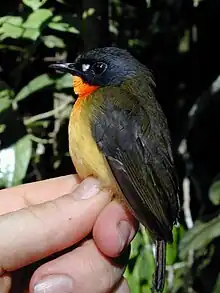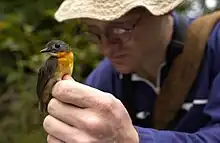Olive-backed forest robin
The olive-backed forest robin (Stiphrornis erythrothorax pyrrholaemus) is a subspecies of the forest robin found in the Gamba Complex in southwest Gabon. It was described in 2008. The olive-backed forest robin can be separated from other subspecies of the forest robin by the combination of its olive upperparts, bright orange throat and chest, and cream-yellow belly. Its song is also distinct from other subspecies of the forest robin. Females are generally duller than males.[2] It has not been evaluated by IUCN, but has been described as locally common.[2]
| Olive-backed forest robin | |
|---|---|
 | |
| Male | |
| Scientific classification | |
| Domain: | Eukaryota |
| Kingdom: | Animalia |
| Phylum: | Chordata |
| Clade: | Dinosauria |
| Class: | Aves |
| Order: | Passeriformes |
| Family: | Muscicapidae |
| Genus: | Stiphrornis |
| Species: | |
| Subspecies: | S. e. pyrrholaemus |
| Trinomial name | |
| Stiphrornis erythrothorax pyrrholaemus Schmidt et al., 2008[2] | |
| Synonyms | |
| |
Though this subspecies was described recently, a juvenile appears to have been collected on 11 November 1953 in Tchibanga, Gabon. The specimen is deposited in the Muséum national d'Histoire naturelle in Paris. Its identity was confirmed by comparison of the DNA sequences.[2]
Taxonomy

All taxa within the genus Stiphrornis were considered part of a single species, S. erythrothorax, until 1999, when it was argued, based on the phylogenetic species concept, that all then-recognized taxa should be considered monotypic species.[3] The split was not followed in Handbook of the Birds of the World, where it was described as "perhaps premature".[4] Comparably, the BirdLife Taxonomic Working Group (and consequently IUCN) recommended not following the split, as differences in plumages are relatively small, genetic sampling was considered incomplete, and evidence for intergradation or parapatry is lacking.[5] Based on mtDNA, S. pyrrholaemus is placed within S. erythrothorax sensu lato, and consequently is considered a species (rather than a subspecies of S. erythrothorax) only if at least some of the taxonomy recommended in 1999 is followed.[2] The genetic divergence between S. pyrrholaemus and other members of the genus is comparable to that between some other closely related species.[2] Clements also split the species.
References
- BirdLife International (2016). "Stiphrornis pyrrholaemus". IUCN Red List of Threatened Species. 2016: e.T22735640A104209434. doi:10.2305/IUCN.UK.2016-3.RLTS.T22735640A104209434.en. Retrieved 12 November 2021.
- Schmidt, Brian K; Jeffrey T. Foster; George R. Angehr; Kate L. Durrant & RC Fleischer (2008). "A new species of African Forest Robin from Gabon (Passeriformes: Muscicapidae: Stiphrornis)" (PDF). Zootaxa. 1850: 27–42. doi:10.11646/zootaxa.1850.1.2.
- Beresford, P. & Cracraft, J. (1999). Speciation in African forest robins (Stiphrornis): species limits, phylogenetic relationships, and molecular biogeography. American Museum Novitates 3270: 1–22. PDF available.
- Collar, N. (2005). Forest Robin (Stiphrornis erythrothorax). Pp. 730–731 in: del Hoyo, J., Elliott, A., & Christie, D. eds. (2005). Handbook of the Birds of the World. Vol. 10. Cuckoo-shrikes to Thrushes. Lynx Edicions, Barcelona. ISBN 84-87334-72-5
- BirdLife International (2018). "Stiphrornis erythrothorax". IUCN Red List of Threatened Species. 2018: e.T103763077A132191967. doi:10.2305/IUCN.UK.2018-2.RLTS.T103763077A132191967.en. Retrieved 12 November 2021. Database entry includes justification for why this species is least concern.
